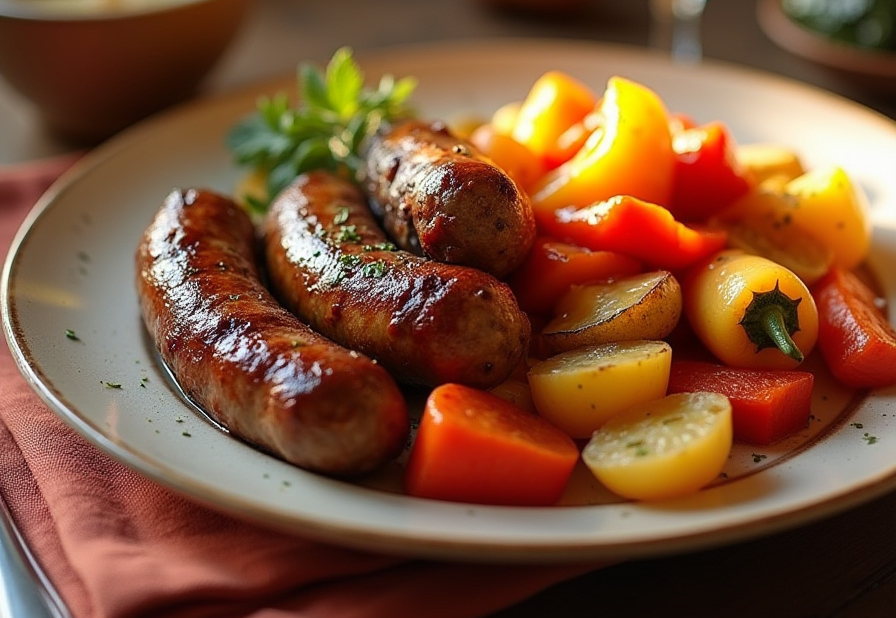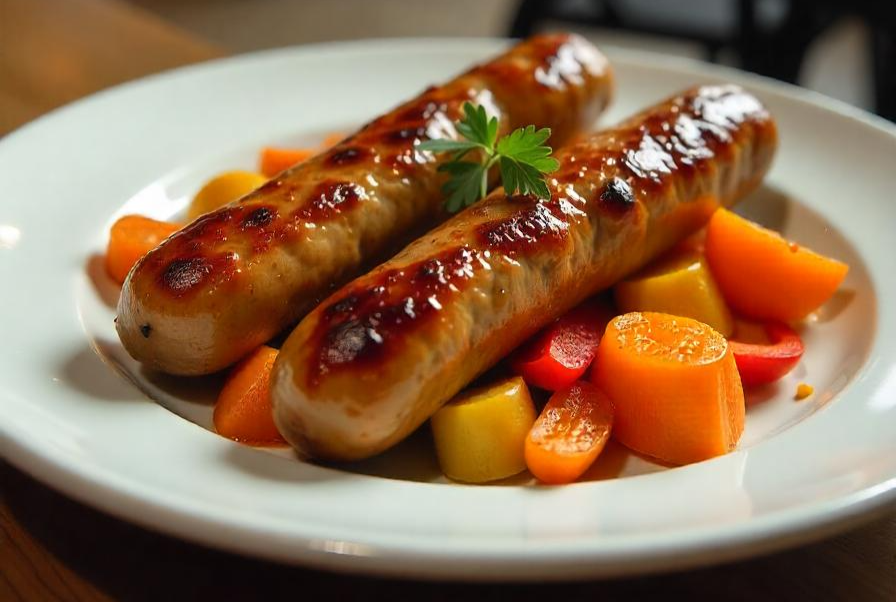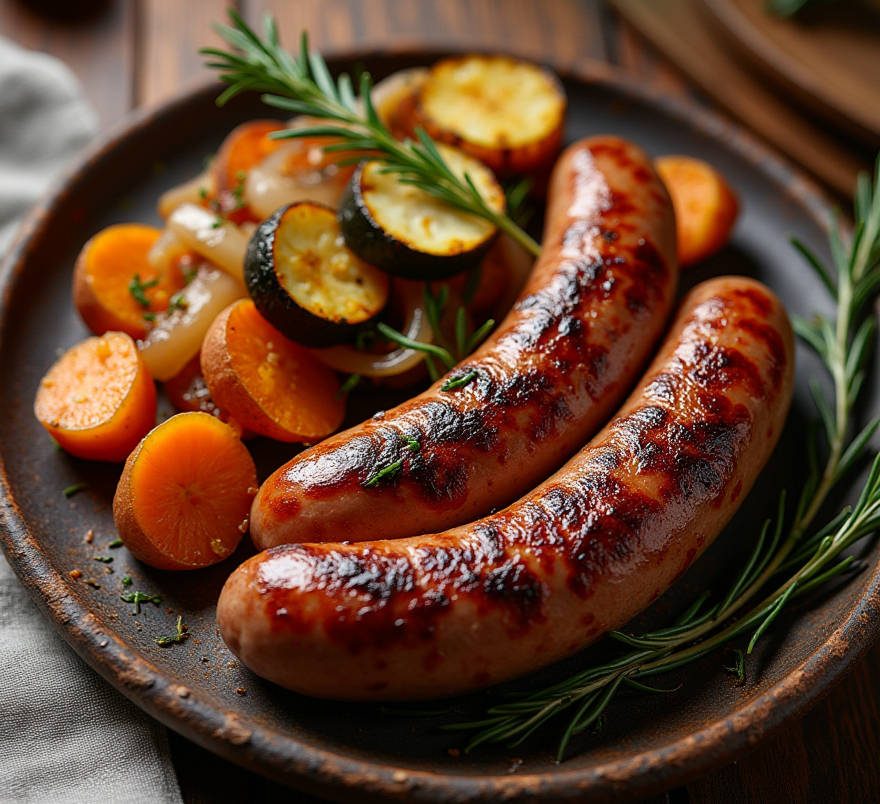Lamb sausage there’s something about it that makes every bite feel indulgent. Whether you’ve had it before or are considering trying it for the first time, lamb sausage is a game-changer in the world of cooking. It’s rich, flavorful, and versatile, making it perfect for all kinds of dishes. From grilling to sautéing, it can be cooked in many ways to bring out its best qualities. But how do you get the perfect sausage every time?
Table of Contents
Why Lamb Sausage Should Be Your New Favorite Meat
It is not just a great alternative to the usual beef or pork sausage; it’s a deliciously unique option that brings a whole new set of flavors to the table. If you’ve been stuck in a sausage rut, constantly cooking the same old flavors, it’s time to shake things up.
It has a distinct flavor that sets it apart from other meats. Its slightly gamey taste, combined with its rich, juicy texture, makes it a treat for your taste buds. Plus, lamb meat is a leaner option than beef or pork, making it a healthier choice without sacrificing flavor.
So why should you choose lamb sausage? Here are a few reasons:
- Rich Flavor: Lamb sausage has a deep, savory flavor that’s packed with complexity. The mild gaminess of lamb adds a richness you don’t get from other meats.
- Versatility: You can pair lamb sausage with a variety of ingredients, from roasted vegetables to couscous, rice, or potatoes. It’s incredibly adaptable and can be used in many different cuisines.
- Healthier Option: While sausages are usually seen as indulgent, lamb is actually a leaner meat compared to beef and pork. It’s a great source of protein, vitamins, and minerals without being too fatty.
It is perfect for those who enjoy hearty, flavorful meals and are looking for something a little different from the norm.
The Rich Flavor of Lamb Sausage
When you take that first bite of lamb sausage, you immediately notice how different it tastes from traditional sausage varieties. The flavor is rich, savory, and slightly gamey, giving it a depth that other sausages often lack. Lamb’s unique profile makes it a perfect meat for sausages, as the spices and herbs it’s paired with can really shine.
The seasoning used in lamb sausage is often bold and aromatic. You’ll find spices like garlic, cumin, coriander, and paprika mixed into the meat. The spices work in harmony with the natural flavors of the lamb to create something irresistible. Lamb sausage doesn’t just taste like any other sausage it’s in a class of its own.
What Makes Lamb Sausage Special?
So, what is it about lamb sausage that makes it stand out? Let’s explore the elements that make this meat a special addition to your kitchen.
The Unique Taste of Lamb Sausage
The first thing you’ll notice when you cook lamb sausage is the unmistakable aroma. The meat has a slightly sweet, earthy fragrance that is distinctively different from pork or beef. Some people describe the flavor as mildly gamey, but in a pleasant way that gives the sausage a more complex, savory depth.
Lamb is known for its rich flavor, and when used in sausage, it takes on a new dimension. The meat’s natural richness pairs perfectly with bold spices, resulting in a sausage that is juicy and tender, with a well-rounded taste.
Unlike other sausages that may be overly greasy, It retains its juiciness without feeling heavy. It’s not just flavorful—it’s satisfying. A good lamb sausage will have a perfect balance between fat and lean meat, giving you the best of both worlds.
Nutritional Benefits of Lamb Sausage
You might be thinking: sausages are delicious, but they can’t be good for you, right? Well, lamb sausage is actually a healthier option compared to other types of sausages. Here’s why:
- Lean Protein: Lamb is a great source of lean protein, which is essential for building and repairing muscles. It’s also filling, so you’ll stay satisfied longer.
- Vitamins and Minerals: Lamb is rich in vitamins and minerals, including iron, zinc, and B vitamins like niacin and riboflavin. These nutrients support everything from immune function to energy levels.
- Lower Fat Content: While lamb does have a higher fat content than chicken, it’s much leaner than pork or beef. This makes lamb sausage a healthier choice, especially when made with lean cuts of lamb.
Learn More About the Nutritional Benefits of Lamb: Check out the USDA Food Database for detailed nutritional data about lamb meat, including its health benefits.
So, while lamb sausage might be seen as indulgent, it actually provides a good amount of nutrition, making it a smart choice for a balanced diet.
Essential Ingredients for Making Lamb Sausage
To make the perfect lamb sausage, you need to start with high-quality ingredients. Here’s a look at what you’ll need to create a delicious homemade lamb sausage.
Choosing the Best Cuts of Lamb
When making lamb sausage, the cut of lamb you use is crucial. You want a good balance of lean meat and fat to ensure the sausage is flavorful and juicy.
- Shoulder: Lamb shoulder is a popular choice for sausage because it has the perfect balance of meat and fat. It’s tender and flavorful when cooked slowly, making it ideal for sausage.
- Leg: Lamb leg is another excellent option. It’s leaner than the shoulder but still provides enough fat to create a juicy sausage.
- Lamb Belly: For a fattier sausage, you can use lamb belly. It adds richness and depth to the sausage, making it even more indulgent.
If you can’t find these specific cuts, ask your butcher for a good mix of lean lamb meat and fat to get the right texture.
Spices and Herbs to Elevate the Flavor of Lamb Sausage
The spices you use in lamb sausage are what really elevate the flavor. Lamb’s natural taste can stand up to bold spices, so don’t hold back! Here’s a list of common spices and herbs that work wonders in lamb sausage:
- Garlic: Fresh garlic is a must in lamb sausage. It adds a savory kick that complements the richness of the lamb.
- Cumin: Cumin adds a warm, earthy flavor that pairs perfectly with lamb. It’s commonly used in Mediterranean and Middle Eastern lamb dishes.
- Paprika: Whether you use sweet or smoked paprika, it gives the sausage a subtle depth and color.
- Thyme: Fresh thyme adds a fragrant, herby note to the sausage that enhances the flavor of the lamb without overpowering it.
Need a refreshing salad to go with your lamb sausage? Discover Broccoli Cauliflower Salad: Recipes, Tips, and Solutions for a nutritious, tasty side dish that complements lamb perfectly.
Delicious Lamb Sausage with Roasted Vegetables to Try
For a comforting, hearty meal, lamb sausage with roasted vegetables is a winning combo. The sausages add richness, while the vegetables add a burst of flavor and texture.
Ingredients:
- 4 lamb sausages
- 2 carrots, chopped
- 1 zucchini, chopped
- 1 bell pepper, chopped
- 1 tablespoon olive oil
- 1 teaspoon thyme
- Salt and pepper to taste
Instructions:
- Preheat your oven to 400°F (200°C).
- Toss the chopped vegetables in olive oil, thyme, salt, and pepper. Spread them out in a single layer on a baking sheet.
- Nestle the lamb sausages among the vegetables and roast for 25-30 minutes, turning halfway through, until the sausages are browned and the vegetables are tender.
- Serve the sausages with the roasted vegetables for a complete meal.

Looking for more sausage recipes? Check out Chicken Apple Sausage: Flavor, Benefits, and Recipes for a healthier sausage alternative with a unique flavor twist.
Common Problems in Making Lamb Sausage and How to Solve Them
Like any dish, making lamb sausage can come with its fair share of challenges. Here are some common problems and solutions to help you get it right every time.
Dry or Crumbly Sausage? Here’s How to Fix It
If your lamb sausage turns out dry or crumbly, it could be because the meat was too lean or overcooked.
How to Fix It:
- Add More Fat: Make sure you’re using the right fat-to-meat ratio (about 20-30% fat). You can also add extra fat to your lamb mixture if necessary.
- Avoid Overcooking: Don’t cook the sausages on high heat. Slow cooking or grilling them on medium heat will keep them tender.
How to Avoid Lamb Sausage from Being Too Greasy
If your lamb sausage ends up greasy, it’s likely because you’ve used too much fat, or the casing isn’t tight enough.
How to Fix It:
- Use Leaner Cuts: Try using a leaner cut of lamb, such as the leg, to reduce the fat content.
- Drain the Fat: After cooking, drain any excess fat from the sausages to avoid greasiness.
Pairing This Sausage with Sides and Drinks
It is flavorful and hearty on its own, but pairing it with the right sides and drinks can take the meal to the next level. Whether you’re serving it for a casual dinner or a special occasion, these combinations will complement the rich flavor of the sausage and round out your meal.
Best Sides to Serve with this Sausage
Lamb sausage pairs beautifully with a variety of sides, from light salads to hearty vegetables. Here are a few of the best options:
- Crispy Roasted Potatoes: The crispy texture of roasted potatoes is the perfect match for the tender, juicy sausage. Roast the potatoes with garlic, rosemary, and a little olive oil for added flavor.
- Grilled Vegetables: Grilled vegetables such as bell peppers, zucchini, and eggplant complement sausage beautifully. The smoky, slightly charred flavor of grilled vegetables pairs perfectly with the savory richness of the sausage.
- Tabbouleh Salad: A refreshing salad made with bulgur, parsley, mint, tomatoes, and lemon juice provides a fresh contrast to the rich flavor of sausage. It’s light, zesty, and packed with flavor.
- Couscous or Rice: Fluffy couscous or rice is a fantastic base for sausage. Add some herbs, raisins, or almonds to the rice for a Mediterranean-inspired twist.
- Sauteed Greens: Greens like spinach, kale, or Swiss chard, sautéed with garlic and olive oil, make a perfect, healthy side dish that balances out the richness of the sausage.

Want more comforting main dishes? Try Macaroni and Tomatoes: A Delicious and Easy Comfort Food for a quick and satisfying meal that pairs well with lamb sausage.
Storing Leftover Lamb Sausage
After enjoying a delicious sausage meal, you might find yourself with some leftovers. No worries it stores well and can be enjoyed later with minimal loss of flavor. Here’s how to store it properly:
How to Store Lamb Sausage for Freshness
If you have leftover lamb sausage, follow these simple steps to keep it fresh:
- Cool It Quickly: Let the sausages cool to room temperature before storing them. This will help prevent moisture from building up inside the storage container, keeping the sausages from becoming soggy.
- Use Airtight Containers: Store the sausages in airtight containers or resealable plastic bags. Be sure to remove as much air as possible to keep them from drying out or absorbing odors from other foods in the fridge.
- Refrigeration: You can keep cooked lamb sausage in the refrigerator for up to 3-4 days. Make sure to eat it within that time for the best taste and safety.
Freezing Lamb Sausage for Long-Term Storage
If you want to store lamb sausage for an extended period, freezing is the way to go. Here’s how to freeze lamb sausage:
- Cool Down Before Freezing: Allow the sausage to cool completely before freezing. This helps maintain its texture and flavor when reheated.
- Wrap and Seal: Wrap the sausages in plastic wrap, then place them in a freezer-safe bag or airtight container. Be sure to remove as much air as possible to prevent freezer burn.
- Label and Date: Write the date on the container or bag, so you know when it was made. Lamb sausage can be stored in the freezer for up to 3 months.
- Reheating from Frozen: To reheat frozen lamb sausage, thaw it in the refrigerator overnight. You can then reheat it in the oven, on the grill, or in a skillet.
Why You Should Make Lamb Sausage Today
It is more than just a meal—it’s an experience. The rich, savory flavor, combined with the perfect blend of spices, makes it a standout dish that can be enjoyed in countless ways. Whether you’re grilling it, frying it, or adding it to a hearty stew, lamb sausage never fails to impress.
By making your own sausage, you have the freedom to experiment with flavors and tailor it to your taste. Plus, it’s a healthier and leaner option than traditional sausages made from beef or pork, making it a smart choice for anyone looking to eat well without sacrificing flavor.
So, what are you waiting for? Get in the kitchen, grab some lamb, and try making your own sausage today. Your taste buds will thank you.
Frequently Asked Questions
Can I use this lamb sausage in other recipes besides grilling?
Yes, absolutely! While grilling is one of the most popular methods, it is incredibly versatile. You can use it in pasta dishes, stews, casseroles, or even crumbled into salads. It’s great when pan-fried, roasted, or even added to soups to give them an extra boost of flavor.
What’s the best way to store raw lamb sausage?
To store raw sausage, keep it in an airtight container or vacuum-sealed bag in the fridge. It’s best to use it within 1-2 days for freshness. If you want to store it longer, you can freeze it for up to 3 months. Just make sure to wrap it tightly to prevent freezer burn.
How do I know when lamb sausage is fully cooked?
It should be cooked to an internal temperature of 160°F (71°C). You can use a meat thermometer to check, or you can slice the sausage open to make sure it’s no longer pink inside. The outside should be nicely browned and crispy, while the inside should be juicy and tender.
Can I make lamb sausage ahead of time?
Yes, you can make it ahead of time! You can either prepare the raw sausage and store it in the fridge until you’re ready to cook, or you can cook it in advance and refrigerate it for up to 3-4 days. You can also freeze cooked sausage for later use.
How can I make lamb sausage spicier?
To add more heat to this sausage, increase the amount of chili flakes, cayenne pepper, or hot paprika. You can also experiment with adding fresh chopped chilies, such as jalapeños or Scotch bonnets, for an extra kick. Just be sure to taste as you go so the heat is balanced to your liking!
Can I make lamb sausage without casings?
Yes, you can make sausage without casings! If you don’t have casings, you can simply form the sausage mixture into patties or rolls and cook them as you would regular sausage. While the casing adds a traditional shape, it’s not essential for flavor or texture.
Is lamb sausage healthier than other sausages?
It is generally considered healthier than pork or beef sausages because lamb is leaner and lower in fat. It also offers a great source of protein, iron, and other essential nutrients. If you’re looking for a sausage with more nutritional value, lamb is an excellent choice.
What should I serve with lamb sausage?
It pairs well with a variety of sides! Some of the best options include grilled vegetables, roasted potatoes, couscous, rice, or a fresh salad. You can also serve it with traditional sides like pita bread or tabbouleh for a Mediterranean-inspired meal.
Can I cook lamb sausage in a slow cooker?
Yes, you can cook it in a slow cooker! Just brown the sausages in a skillet first, then place them in the slow cooker with vegetables, stock, and any seasonings. Cook on low for 4-6 hours, and you’ll have tender, flavorful lamb sausage ready to serve.

